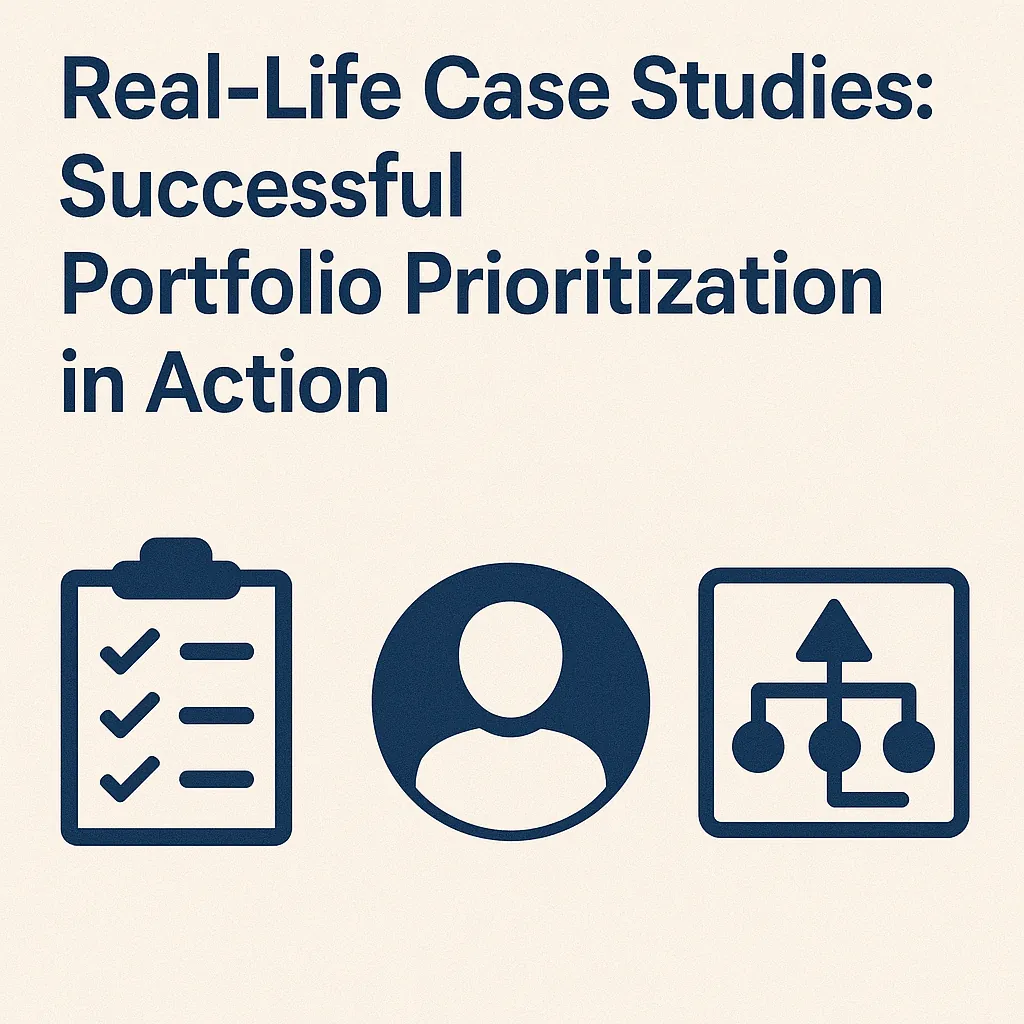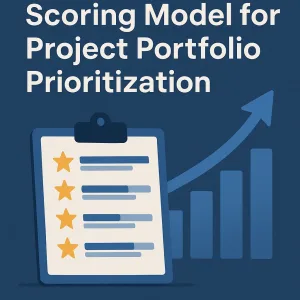Introduction to Portfolio Prioritization
Portfolio prioritization is a critical process that involves evaluating and selecting projects based on their alignment with an organization’s strategic goals. This practice is not merely a list-making exercise; it is an essential component of Project Portfolio Management (PPM), which focuses on ensuring that all projects within a portfolio contribute to the overarching objectives of the organization. By defining clear strategic goals and establishing prioritization criteria, organizations can effectively manage their project portfolios to maximize value and impact.
The Role of Portfolio Prioritization in Project Management
Portfolio prioritization serves several key functions in project management:
- Strategic Alignment: It ensures that the selected projects align with the organization’s strategic objectives, thereby enhancing the likelihood of achieving desired outcomes. This alignment is crucial as it helps organizations focus their efforts on initiatives that deliver the most significant value [1][5].
- Resource Allocation: Effective prioritization allows organizations to allocate limited resources—such as time, budget, and personnel—more efficiently. By scoring projects based on their potential strategic value, project managers can make informed decisions about which projects to pursue, ensuring that resources are directed toward initiatives that promise the highest returns [2][15].
- Risk Management: Prioritization also aids in identifying and mitigating risks associated with project execution. By evaluating projects against established criteria, organizations can better understand the potential challenges and benefits of each initiative, allowing for more strategic decision-making [4][6].
Significance of Effective Prioritization
The significance of effective portfolio prioritization cannot be overstated. In a landscape where organizations often face competing demands and limited resources, the ability to prioritize projects effectively is essential for success. Key benefits include:
- Maximizing Value Delivery: Organizations that prioritize projects based on their strategic value are more likely to achieve their goals and deliver maximum value through their initiatives. This approach fosters a culture of accountability and ensures that all stakeholders are aligned with the organization’s vision [15].
- Enhanced Decision-Making: A structured prioritization process provides a clear framework for decision-making, enabling project managers and executives to evaluate projects objectively. This clarity helps in negotiating with various stakeholders and balancing differing priorities [4][5].
- Improved Portfolio Performance: By continuously monitoring and adjusting project priorities, organizations can enhance the overall performance of their project portfolios. This adaptability is crucial in responding to changing market conditions and organizational needs [6][7].
Overview of the Blog’s Approach
In this blog, we will delve into real-life case studies from leading organizations that have successfully implemented portfolio prioritization strategies. By analyzing these examples, we aim to highlight best practices, lessons learned, and the tangible benefits that effective prioritization can bring to project management. Our focus will be on how these organizations navigated the complexities of project selection and resource allocation, ultimately achieving strategic alignment and maximizing their project outcomes. Through these insights, we hope to provide valuable guidance for project managers and business executives looking to enhance their own portfolio management practices.
Understanding the Challenges of Portfolio Prioritization
Effective portfolio prioritization is crucial for aligning projects with strategic objectives and ensuring optimal resource allocation. However, organizations often encounter several challenges that can hinder their ability to prioritize effectively. Below are some key challenges faced by project managers and business executives when managing project portfolios.
Complexities of Managing Multiple Projects with Limited Resources
One of the primary challenges in portfolio prioritization is the complexity involved in managing multiple projects simultaneously, especially when resources are limited. Organizations frequently struggle with:
- Resource Allocation: Balancing personnel, equipment, time, and budget across various projects can be daunting. Ineffective resource allocation can lead to project delays and increased costs, ultimately affecting the overall success of the portfolio [15].
- Capacity Planning: Without proper capacity planning, organizations may find themselves overcommitted, leading to burnout among team members and a decline in project quality. This can create a cycle of inefficiency that hampers the ability to prioritize effectively [15].
Conflicting Stakeholder Interests
Another significant challenge in portfolio prioritization arises from conflicting interests among stakeholders. Different stakeholders often have varying priorities and expectations, which can complicate decision-making processes. Key points include:
- Diverse Objectives: Stakeholders may prioritize projects based on their individual goals rather than the organization’s strategic objectives. This misalignment can lead to disputes and hinder consensus on project prioritization [4].
- Communication Gaps: Poor communication among stakeholders can exacerbate conflicts, making it difficult to reach a unified decision on which projects should take precedence. This lack of alignment can result in wasted resources and missed opportunities [4].
Risks of Poor Prioritization
The consequences of inadequate prioritization can be severe, impacting not only individual projects but also the organization as a whole. Some of the risks associated with poor prioritization include:
- Misalignment with Strategic Goals: When projects are not prioritized according to the organization’s strategic objectives, it can lead to a disconnect between project outcomes and business goals. This misalignment can ultimately hinder growth and competitiveness [13].
- Increased Project Failure Rates: Poor prioritization can result in a higher likelihood of project failures, as resources may be allocated to less critical initiatives while more important projects are neglected. This can lead to financial losses and damage to the organization’s reputation [15].
- Inefficient Use of Resources: When projects are not prioritized effectively, organizations may find themselves investing time and money into initiatives that do not yield significant returns. This inefficiency can strain resources and limit the organization’s ability to pursue more valuable opportunities [15].
Understanding the challenges of portfolio prioritization is essential for project managers and business executives. By recognizing the complexities of managing multiple projects, addressing conflicting stakeholder interests, and mitigating the risks associated with poor prioritization, organizations can enhance their project portfolio management practices and drive better outcomes.
Company A – Implementing a Scoring Model
Overview of Company A’s Project Landscape and Initial Challenges
Company A operates in a highly competitive industry where effective project management is crucial for maintaining market leadership. Initially, the organization faced significant challenges in managing its diverse project portfolio. The lack of a structured approach to prioritization led to resource misallocation, with high-priority projects often sidelined in favor of less critical initiatives. This resulted in delayed project timelines, increased costs, and a decline in overall project success rates. Recognizing the need for a more systematic method, Company A sought to implement a robust prioritization framework to enhance decision-making and optimize resource utilization.
Description of the Scoring Model Used for Prioritization
To address these challenges, Company A adopted a scoring model designed to evaluate and prioritize projects based on a set of predefined criteria. The scoring model included the following key components:
- Criteria Selection: The organization identified several critical criteria for project evaluation, including strategic alignment, potential ROI, resource requirements, risk assessment, and stakeholder impact. Each criterion was deemed essential for ensuring that projects aligned with the company’s strategic goals.
- Scoring System: Each project was assessed against the selected criteria using a numerical scoring system. Projects were rated on a scale of 1 to 5 for each criterion, with 5 indicating the highest alignment or potential. The scores were then aggregated to produce an overall score for each project, allowing for a clear comparison across the portfolio.
- Weighting Factors: To further refine the prioritization process, Company A applied weighting factors to each criterion based on its importance to the organization’s strategic objectives. This ensured that projects contributing more significantly to the company’s goals received higher priority in the allocation of resources.
Results Achieved Post-Implementation
The implementation of the scoring model yielded significant improvements in Company A’s project management processes:
- Improved Resource Allocation: By utilizing the scoring model, Company A was able to allocate resources more effectively, ensuring that high-priority projects received the necessary attention and support. This led to a more balanced distribution of resources across the project portfolio.
- Increased Project Success Rates: The structured approach to prioritization resulted in a notable increase in project success rates. Projects that aligned closely with strategic objectives and demonstrated high potential for ROI were completed on time and within budget, enhancing overall organizational performance.
- Enhanced Decision-Making: The scoring model facilitated more informed decision-making among project managers and executives. With clear visibility into project priorities, stakeholders could engage in more strategic discussions, leading to better alignment of projects with business goals.
Company A’s successful implementation of a scoring model for project prioritization not only addressed initial challenges but also positioned the organization for sustained success in a competitive landscape. This case study exemplifies how structured prioritization frameworks can drive effective project management and enhance organizational performance.
Company B – Agile Portfolio Management
Introduction to Company B and Its Shift Towards Agile Project Management
Company B, a prominent player in the technology sector, recognized the need to adapt its project management approach to remain competitive in a rapidly changing market. Faced with challenges such as shifting customer demands and the necessity for faster delivery times, the organization decided to transition from traditional project management methodologies to agile project management. This strategic shift aimed to enhance its portfolio prioritization processes, allowing for more dynamic decision-making and resource allocation.
Explanation of Agile Principles Applied to Portfolio Prioritization
In adopting agile methods, Company B implemented several key principles that significantly impacted its portfolio prioritization:
- Flexibility: Agile methodologies emphasize the importance of being adaptable to change. Company B established a framework that allowed project teams to pivot quickly in response to new information or market conditions. This flexibility enabled the organization to prioritize projects that aligned more closely with current business objectives and customer needs.
- Iterative Processes: The agile approach promotes iterative development, where projects are broken down into smaller, manageable increments. Company B adopted this principle by regularly reviewing and adjusting its project portfolio based on performance metrics and stakeholder feedback. This iterative process ensured that the most valuable projects received the necessary resources and attention, while less critical initiatives could be deprioritized or shelved.
Outcomes of Agile Adoption
The transition to agile portfolio management yielded several positive outcomes for Company B:
- Increased Responsiveness: By embracing agile principles, Company B became more responsive to changes in the market and customer preferences. The organization could quickly reallocate resources to high-priority projects, ensuring that it remained competitive and relevant in its industry.
- Better Alignment with Business Goals: Agile portfolio management facilitated a closer alignment between project outcomes and overarching business objectives. Company B’s leadership was able to make informed decisions about project prioritization, ensuring that the portfolio reflected the company’s strategic vision and goals. This alignment not only improved project success rates but also enhanced overall organizational performance.
Company B’s shift towards agile project management exemplifies how adopting agile principles can significantly enhance portfolio prioritization. By fostering flexibility and iterative processes, the organization achieved increased responsiveness and better alignment with its business goals, ultimately driving success in a competitive landscape.
Company C – Data-Driven Decision Making
Background on Company C and Their Reliance on Data Analytics
Company C, a prominent player in the manufacturing sector, has embraced data analytics as a cornerstone of its project management strategy. Recognizing the increasing complexity of project demands and the necessity for informed decision-making, the organization has integrated data-driven methodologies into its portfolio prioritization processes. This shift has allowed Company C to enhance visibility across projects, streamline operations, and align initiatives with strategic objectives, ultimately leading to improved performance and resource allocation.
Methods of Data Collection and Analysis Employed for Prioritization
To effectively prioritize projects, Company C employs a robust framework for data collection and analysis. Key methods include:
- Quantitative Data Analysis: The company utilizes advanced analytics tools to gather quantitative data from various sources, including project performance metrics, resource availability, and financial forecasts. This data is crucial for assessing the potential return on investment (ROI) of each project.
- Qualitative Insights: In addition to quantitative data, Company C incorporates qualitative insights from stakeholder feedback and expert opinions. This dual approach ensures a comprehensive understanding of project impacts and stakeholder expectations.
- Predictive Analytics: By leveraging predictive analytics, Company C can forecast project outcomes based on historical data and current trends. This capability allows project managers to identify high-priority projects that align with strategic goals and have the highest likelihood of success.
- Balanced Scorecard Approach: The organization employs a balanced scorecard framework to evaluate projects against multiple criteria, including financial performance, customer satisfaction, internal processes, and learning and growth. This holistic view aids in making informed prioritization decisions.
Impact of Data-Driven Decision-Making on Project Outcomes and Stakeholder Satisfaction
The implementation of data-driven decision-making has had a significant impact on Company C’s project outcomes and stakeholder satisfaction:
- Enhanced Project Success Rates: By prioritizing projects based on data analytics, Company C has seen a marked improvement in project success rates. Projects that align closely with strategic objectives and demonstrate strong ROI are more likely to be completed on time and within budget.
- Increased Stakeholder Engagement: The reliance on data analytics has fostered greater transparency and communication with stakeholders. By providing data-backed justifications for project prioritization, Company C has enhanced stakeholder trust and engagement, leading to higher satisfaction levels.
- Optimized Resource Allocation: Data-driven insights have enabled Company C to allocate resources more effectively, ensuring that high-priority projects receive the necessary support while minimizing waste on lower-priority initiatives. This optimization has resulted in improved operational efficiency and cost savings.
- Continuous Improvement: The organization has established a feedback loop where project outcomes are analyzed post-completion, allowing for continuous refinement of prioritization methods. This iterative process ensures that Company C remains agile and responsive to changing market conditions and stakeholder needs.
Company C’s commitment to data-driven decision-making in portfolio prioritization exemplifies how organizations can leverage analytics to enhance project management practices. By employing a comprehensive approach to data collection and analysis, the company has achieved significant improvements in project outcomes and stakeholder satisfaction, setting a benchmark for others in the industry.
Key Takeaways
Effective portfolio prioritization is crucial for aligning projects with organizational goals and ensuring resource optimization. Analyzing successful case studies from leading organizations reveals several key themes and strategies that can guide project managers and business executives in their prioritization efforts.
Common Themes and Strategies for Successful Prioritization
- Data-Driven Decision Making: Organizations that excel in portfolio prioritization often leverage data analytics to inform their decisions. By improving data quality and utilizing metrics, they can better assess project impacts and align them with strategic objectives [7].
- Clear Objectives and Criteria: Successful organizations establish clear criteria for project selection and prioritization. This clarity helps teams understand which projects align best with the overall strategy, thereby reducing ambiguity and enhancing focus [15].
- Cross-Functional Collaboration: Engaging multiple departments in the prioritization process fosters a holistic view of project impacts. This collaboration ensures that all relevant perspectives are considered, leading to more informed decision-making [11].
Importance of Aligning Projects with Strategic Organizational Goals
Aligning projects with strategic goals is paramount for maximizing organizational effectiveness. When projects are directly linked to the overarching strategy, organizations can:
- Enhance Resource Allocation: By prioritizing projects that support strategic objectives, organizations can allocate resources more effectively, ensuring that critical initiatives receive the necessary support [4].
- Accelerate Project Delivery: Projects that are aligned with strategic goals tend to progress more smoothly, as they are backed by a clear vision and organizational commitment. This alignment can lead to faster project completion and reduced time to market [4].
- Reduce Project Failure Rates: Good prioritization practices help eliminate waste and streamline processes, which in turn reduces the likelihood of project failures. Organizations that prioritize effectively are better positioned to navigate challenges and adapt to changing circumstances [4][5].
Flexibility and Adaptability in Prioritization Processes
The dynamic nature of business environments necessitates a flexible approach to portfolio prioritization. Key insights include:
- Proactive Risk Management: Successful organizations incorporate risk management into their prioritization processes. By anticipating potential challenges and adjusting priorities accordingly, they can maintain momentum even in the face of uncertainty [15].
- Continuous Improvement: Organizations that prioritize adaptability often engage in regular reviews of their project portfolios. This practice allows them to reassess priorities based on new information, changing market conditions, or shifts in organizational strategy [15].
- Responsive Frameworks: Implementing frameworks that allow for quick adjustments in project prioritization can significantly enhance an organization’s ability to respond to emerging opportunities or threats. This responsiveness is critical for maintaining competitive advantage in fast-paced industries [5][6].
The insights gained from analyzing successful portfolio prioritization case studies underscore the importance of data-driven decision-making, alignment with strategic goals, and the need for flexibility. By adopting these practices, project managers and business executives can enhance their project management capabilities and drive organizational success.
Best Practices for Effective Portfolio Prioritization
Effective portfolio prioritization is crucial for aligning projects with strategic goals and optimizing resource utilization. Here are some best practices that project managers and business executives can adopt to enhance their portfolio prioritization processes:
1. Establish Clear Prioritization Criteria
- Define Strategic Alignment: Ensure that each project aligns with the organization’s strategic objectives. This involves evaluating how well a project supports the overall mission and vision of the company [8].
- Assess Return on Investment (ROI): Prioritize projects based on their potential financial returns. Establishing a clear ROI metric helps in making informed decisions about which projects to pursue [8].
- Incorporate Risk Assessment: Evaluate the risks associated with each project. Projects with lower risk profiles may be prioritized higher, especially in uncertain business environments [8].
2. Utilize Effective Tools and Frameworks
- Eisenhower Matrix: This framework helps categorize projects based on urgency and importance, allowing managers to focus on what truly matters [2].
- Value vs. Complexity Analysis: This tool assists in visualizing the trade-offs between the value a project brings and the complexity involved in its execution, helping to prioritize projects that offer high value with manageable complexity [2].
- Project Portfolio Management (PPM) Software: Centralizing data and decision-making through PPM tools can streamline the prioritization process. These tools provide insights into project performance and resource allocation, facilitating better decision-making [5][12].
3. Encourage Continuous Review and Adaptation
- Regular Portfolio Reviews: Establish a routine for reviewing the project portfolio to ensure that prioritization remains aligned with changing business contexts. This could involve quarterly or bi-annual assessments [14].
- Adapt to Market Changes: Be responsive to shifts in the market or organizational strategy. Projects may need to be reprioritized based on new opportunities or challenges that arise [14].
- Feedback Loops: Implement mechanisms for gathering feedback from stakeholders and team members. This can provide valuable insights into the effectiveness of current prioritization strategies and highlight areas for improvement [12].
By adopting these best practices, project managers and business executives can enhance their portfolio prioritization efforts, ensuring that their organizations remain agile and focused on achieving strategic goals.
Conclusion
Successful portfolio prioritization stands as a cornerstone for achieving organizational goals and maximizing resource efficiency. The case studies analyzed throughout this blog have illustrated how leading organizations effectively navigate the complexities of project selection and prioritization. These real-life examples highlight several key takeaways:
- Significance of Prioritization: Effective portfolio prioritization enables organizations to align their projects with strategic objectives, ensuring that resources are allocated to initiatives that deliver the highest value. This alignment not only enhances project outcomes but also fosters a culture of accountability and transparency within teams. As demonstrated in various case studies, organizations that prioritize effectively are better positioned to respond to market changes and stakeholder needs, ultimately leading to sustained success [1][8].
- Application of Insights: The strategies and frameworks discussed in the case studies provide valuable insights that project managers and business executives can implement within their own organizations. By adopting best practices in portfolio management, such as utilizing data-driven decision-making and fostering cross-functional collaboration, organizations can enhance their project selection processes. The experiences shared by these leading organizations serve as a blueprint for others looking to refine their approach to portfolio prioritization [2][11].
The importance of successful portfolio prioritization cannot be overstated. It is a critical factor that influences project success and organizational performance. By learning from the successes of others and applying these insights, project managers and business executives can drive their organizations toward greater efficiency and effectiveness in project delivery.
Find out more about Shaun Stoltz https://www.shaunstoltz.com/about/.
This post was written by an AI and reviewed/edited by a human.



